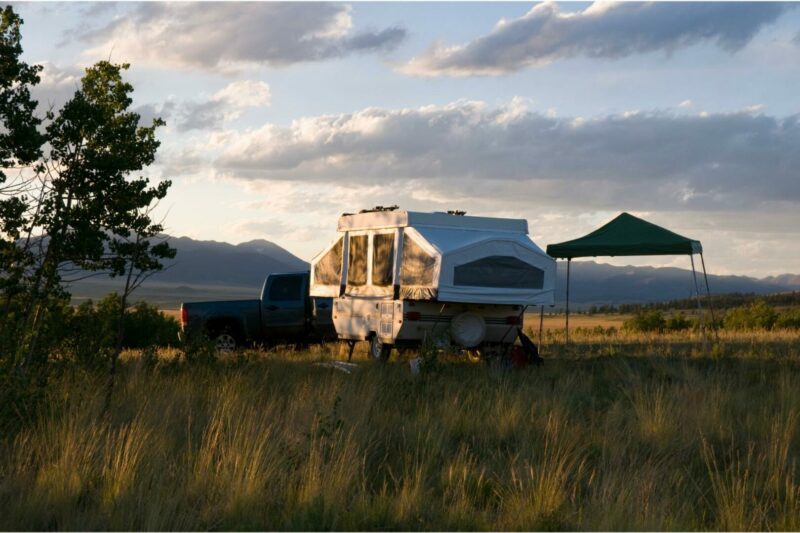Table of Contents Show
In 1967, a new model in the camping scene took tent campers by storm, offering nights spent under a canvas but in trailer form with more conveniences of home. The Coleman pop-up camper was born, an RV that mixed tent camping in nature with the comforts of a kitchen, a bathroom, and beds off the ground.
But after almost 50 years of popularity, the Coleman pop-up camper disappeared off the production line. Here’s why:
Coleman Means Camping
Started as a lantern company in the early 1900s, the Coleman Company became synonymous with camping equipment and campers over the last decade. Its founder, W.C. Coleman, created gas-fueled lanterns that burned brighter than the existing kerosene ones early in the last century. The lanterns lit the first evening football game west of the Mississippi using Coleman lanterns around the field at Fairmont College in Wichita, Kansas.

From illuminating the outdoors to refrigerating and heating food without electricity, Coleman became the premier camping equipment manufacturer. Some of their popular product included the Coleman Cooler and the Coleman Camp Stove. And by 1967, the company created its first camper, the innovative pop-up that mixed tent camping with RVing by building a mobile trailer that was half-canvas/half-solid wall.
Pro Tip: Find out what is considered a pop-up camper.
The History Of The Coleman Pop Up Camper
Known as “the company that created better products for outdoor living,” Coleman grew from a manufacturer of small camping appliances to a producer of recreational vehicles. We’ll look at some of their history below.
The Folding Camper Division
In 1966, after sixty years of success with Coleman lanterns, coolers, and camp stoves, Sheldon Coleman, the son of company founder W.C. Coleman, created the Folding Camper Division to produce pop-up campers. These new recreational vehicles were sleekly-styled camping trailers, equipped with premium quality materials.
Coleman even promised coast-to-coast authorized service from the first model (the CT-1) to the last. This new hybrid was an immediate success.

About the Campers
The pop-up trailer was designed to be lightweight and long-lasting. It appealed to serious campers and hobbyists, as well, because relatively small vehicles could tow it. Plus, it featured quality materials that would last for many years.
The first model boasted a bay window galley and three double beds, measuring 6’ 8” wide by 8’ 9” long when contracted and 16ft long when fully open. Tent campers fell in love with the pop-up trailer, seeing it as a step up to RVing but with the nostalgia of a tent. Coleman found itself producing most of the pop-up campers in the country by 1979.
Coleman to Fleetwood
The 1980s saw Coleman’s profits continue to grow, even as solid-walled trailers and motorhomes entered the scene with a vengeance. But by 1989, Fleetwood had purchased the company and continued producing the pop-up trailers under the Fleetwood moniker.
By 1996, the company hit its highest revenues, but a few years later found itself in debt. Restructuring and implementing some cost-cutting procedures kept the company afloat. By 2008, Fleetwood offered a new licensing agreement so that the pop-up campers could fall under the trusted Coleman name once again.
They would produce these newly ‘renamed’ camper trailers for another three years before Coleman closed its doors, seemingly for good in 2011.
Today, you’ll find the Coleman name on a small line of high-quality travel trailers that Dutchmen RV makes. Still, its iconic pop-up camper is now retired as a favored vehicle for generations of families.
When Did Coleman Stop Making Pop-Up Campers?
When Fleetwood bought out the Coleman Company in 1989, they continued feeding Coleman’s growth under their tutelage for several years. But, taking the Coleman name off their well-known campers just to save licensing fees didn’t appear to help their bottom line. Within 10 years, sales began to flounder, and finally, Fleetwood negotiated a new licensing agreement. Coleman pop-ups were again produced from 2008 to 2011.
It appears at this time that Coleman began to focus on specific camping equipment, leaving the pop-up camper by the wayside. But they kept the quality they had become known for in all of their existing products.
In 2015, the Newell Group purchased the brand, and they now produce tents, stoves, lanterns, grills, and sleeping bags.

How Much Does a Coleman Camper Cost on the Secondary Market?
Even though these campers were discontinued, you can still find used Coleman pop-up campers. Purchase prices range from $2,000 to $17,000, based on the condition of the canvas and equipment in the trailer. Many consider these campers collectibles because the company no longer produces them.
Don’t Fret: If you’re looking for a high-quality pop-up camper, you have to read about The 7 Best Pop-Up Campers on the Market.
Will the Coleman Camper Make a Comeback?
It’s doubtful that the Coleman pop-up camper will return in a new form. But the brand is still alive and kicking in a travel trailer line that Dutchmen produces. While these trailers aren’t exactly the same, they still have pop-up features and products reminiscent of the old pop-ups.
Keep In Mind: These are the top 7 regrets of owning a pop-up camper.
Now You Know
The mystery of the disappearing camper has finally been told. But now that you know the story, don’t you find the Coleman pop-up camper even more endearing?
This little trailer helped tent campers upgrade to indoor kitchens and bath facilities. It also introduced many families to an adventurous way to explore the outdoors. It’s easy to see why so many cherish this groundbreaking product from a company renowned for its quality and attention to detail.







I would buy a Coleman Pop-up today if someone would build the high quality ones they made.
Miss them so much and loath the hardside houses on wheels. Might as well stay at home.
The Coleman name was on the trailers long after 1989. It wasn’t until 2006 that they pulled the Coleman name and put only Fleetwood on them and that only lasted 2 years as Coleman name was back on them for the 2008 model year.